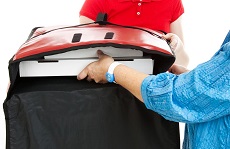
The history of food delivery dates back all the way to the 18th century in the West, and stretches back even further if you look towards China and its neighboring countries. However, most restaurants really started focusing on food deliveries in the 1950s (when fast-food restaurants and mobile food trucks started becoming popular), owners and managers alike have been trying to find ways to increase their overall ROI (in terms of the money they spend on their delivery service).
The advent of mobile-based apps such as Uber Eats, GrubHub, and Postmates, has compounded this issue even further. While internet-based food delivery can trace its origins back to the early days of the web (1995), nobody could have foreseen the growth of the industry to what it’s become (especially in wake of the COVID-19 pandemic).
Whether you’re a small, locally-owned business trying to survive the pandemic, or you have numerous locations spread out across several regions, the tips posted in this article will help you take control of your business’s delivery ROI. We cover everything from custom hot food delivery bags to creating an omnichannel experience for your customers. Not only that, but you’ll also learn about how to effectively streamline your restaurant’s day-to-day operations (which in turn will help boost your bottom line).
Enhancing Your Restaurant’s Delivery Operations
While the COVID-19 pandemic has certainly put a damper on restaurant owners (and staff) across the world, one area where the industry has seen an immense explosion in customer behavior is delivery. Whether you currently partner with Uber Eats, GrubHub, or any number of food delivery apps (or all of them), or are interested in expanding your delivery operations, chances are that you want to minimize the extra cost that those services will undoubtedly add to your bottom line.
Something that’s important to note, and something that’s also often overlooked by eager restaurant owners and managers, is the fact that adding multiple delivery services to your restaurant’s operations has the potential to make your day-to-day operations more complex. With that being said, it would be foolish to not offer at least one app-based delivery service.
Omnichannel Restaurant Sales
Over the past few years, the buzzword “du jour” in the business world (especially in commerce and sales) has been “omnichannel selling.” Without getting too deep into jargon-filled definitions, omnichannel simply means making sure that your business can sell across all possible channels (e.g. in-person, over the phone, on the internet, through a mobile app, etc.).
The key underlying principle to your restaurant having a top-notch omnichannel experience is by ensuring (as much as possible) that the ordering, delivery, and food experience remains the same (no matter which “channel” the sale originated from). This is one of the easiest ways to retain current customers and attract new ones – don’t underestimate the importance of making the customer’s experience a priority.
Many restaurants use multiple combinations of different apps with great success. These businesses also have strong management, streamlined delivery protocols, and have probably added some extra training for their shift employees. If you’re wondering how to make your delivery service more streamlined and less complex, keep on reading.
Getting the Most Out of Your Restaurant’s Delivery Sales
Don’t be one of the countless restaurant owners who sign up with one of the popular mobile-based delivery apps on a whim with no plan or strategy for implementing a successful delivery experience. Food delivery has the potential to be a logistical nightmare. Couple that with untrained staff and ill-defined delivery protocols, and your restaurant will be left in the dust by the competition.
Establishing employee guidelines, as well as delivery pick-up areas, dropoff locations, etc. should all be near the top of your initial to-do list. Employee training is one of the most critical areas. Staff members need to be fluent in processing delivery orders, getting them properly sent to the kitchen, and know exactly what protocol to follow (depending on which app or delivery method the customer is using).
The customer’s experience is paramount to everything in hospitality, and this includes the restaurant industry. Seasoned owners and managers know this, and work to ensure the lifeblood of their restaurant by making customer satisfaction one of their top priorities.
Some restaurants make the mistake of looking at delivery orders as less important than in-restaurant orders, or takeout, etc. Don’t make this same mistake. Focus on creating an omnichannel experience that delivers the same excellent food to your customers, whether they order through an app or call you directly over the phone.
Image: Lisa F. Young / Shutterstock.com






